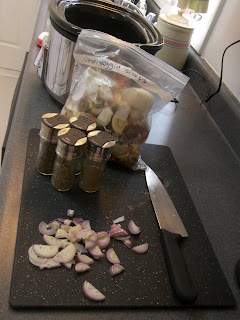Volume: Fill the pot between halfway and two-thirds full. Try getting away with no more than 1 cup of liquid and try broths, wine, or vegetable juice instead of water. If the resulting liquid i too watery, you can reduce it on the stovetop.
Location, Location, Location: Because vegetables take longer than meat to cook, place them at the bottom of the pot so they can stew in the liquid. For delicate vegetables or recipes that cook vegetables for 10 hours or more, seal them in a foil pack and place it on the top layer -- it slows their cooking time and keeps their flavor distinct.
Pre-Pot Prep: Left without direction, crockpot ingredients can take on a dull, "crockpotty" taste that you will recognize whether you slow-cooked a pork tenderloin over potatoes and carrots or borscht with onions, beets, and cabbage. Except for simple recipes like rehydrating beans and simmering stock, it's important to guide the flavor of the meal before placing it in the pot. You can do that by browning the meat in the appropriate seasonings or sauteing the seasonings into the onions. With onions, you can even do that the night before you start your meal, and keep it cool in the fridge overnight. (But storing browned meat that's raw in the middle in the fridge overnight isn't recommended)
Vegetarian Flavor Saver: Browning meat creates a tasty fond that can be replaced by sauteeing onions in seasoning before adding to the pot. If you are adapting a non-slow-cooker recipe, it's generally safe to triple the onions and seasonings when you saute, as it reduces the volume of the onions and locks in the flavor. For a meat stew or braise, add tomato paste - up to 1/4 cup -- and saute with the onions. Soy sauce is another way to deepen and round out the flavor of a stew without adding any distinctive flavor of its own. If you like mushrooms, try porcini mushrooms, they add a nice flavor and color, but not without a distinctive mushroom flavor.
Keeping it Lean: The best meats for crockpot recipes are marbled with fat; they are delicious and tender when stewed for hours. Lean meats are more susceptible to drying out and will have less liquid to release into the pot when it's cooking. If you substitute a fattier cut of meat for a leaner meat in a particular recipe, use the lesser of the cooking times in the recipe and err on the side of including more liquid than listed in the recipe. Alternatively, if you choose to use the fattier meat in the recipe, brown it beforehand and drain the fat from the skillet, use a fat skimmer or fat separator after the meal is cooked, or scrape the fat off of the top after the stew cools in the fridge.
Adapting Non-Crockpot Recipes: 30 minutes on the stove or in the oven is the equivalent of 1 hour in the crockpot on high, or 2 hours on low. Generally, the low setting cooks at just below a boil and high at just above a boil. Lifting the lid of the crockpot and letting steam escape while it is cooking loses 30 minutes of cooking time. So, if you must lift the lid, add another half hour to the cooking time.
Do Not:
- Cook dried beans with the recipe -- they need to be rehydrated separately.
- Cook pasta with the recipe -- cook them separately on the stove until tender and add to the crockpot toward the end of cooking.
- Add frozen vegetables -- thaw them first so they don't lower the temperature of the other ingredients.
- Add thawed frozen vegetables in the last hour of cooking.
- Start with chilled meat unless the liquid you add is boiling
Share your some of your slow-cooker tips!






